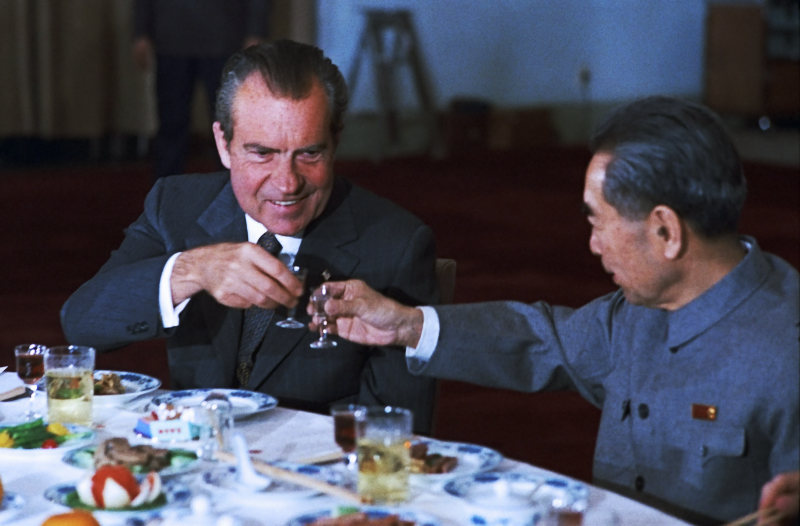Modern Chinese History
China's Space Mission China is putting a great deal of money and effort in building a space exploration program . Already missions have put people into orbit around the Earth and landed robots onto the Moon. Plans exist for a large space lab and manned landings on the Moon and even missions to Mars. In a race to put people on Mars it could well be China that gets there first. Read more…
Relations with Taiwan - the One China Policy An exploration into the current debate about the status of Taiwan with a look into the complex history and some thoughts on the future. Read more…
Modern Leaders The leadership of the People's Republic since 1949 has been one of stability with an emphasis on steady progress. With China such a major power it is important to understand the background to the handful of people who have led China in a new direction. Read more…
Superpower China An in-depth overview of the position of China in the world and its likely future. Is China on track to become the leading world super-power as it once was? For thousands of years China was by any measure the top nation on Earth, and so it seems natural that after 150 years of turmoil China will become the leading country again. We speculate on what this might mean to China and the rest of the world. Read more…
4th May 1919 The Chinese reaction to the Versailles Treaty was the major turning point in modern Chinese history. Widespread student protests throughout the country led to a change in government policy and a refusal to sign the treaty. It was a nationalist movement calling for solidarity against foreign exploitation that was eventually to lead to a militarized Guomindang as well as the foundation of the Chinese Communist Party. Read more…
Dip into history Our history section has a page for each major dynasty, for the whole period from the time of myths and legends 5,000 years ago all the way through the Han, Tang, Song, Ming dynasties to the last great dynasty the Qing. Read more…
Best China Sights In this page we give information on the top attractions all over China to tempt you to explore further. Each attraction is clearly marked on a map and further information on each place is readily available. From furthest Heilongjiang to Hong Kong and Lhasa to Shanghai we have selected the top travel highlights. Read more…
All the tea in China
Tea was the most important export that was weighed in the traditional Chinese unit of measurement called a 'catty'. It is known colloquially as the Chinese pound and is about 1.1pounds. In China it is known as the jin 斤 the word catty probably came from the Malay word. The modern weight is aligned to the metric system as exactly 500grams. The container for tea, a 'caddy', is believed to have been named after the measure.
The illustrious Ming dynasty The most famous Chinese dynasty is the Ming dynasty . China emerged from the Mongol conquest to become pre-eminent nation, with the greatest wealth, population and foreign trade of any nation. It was during the Ming dynasty that China achieved many accomplishments: a vast fleet sailed the seas and made many discoveries and an encyclopedia of all knowledge was distilled into 11,000 chapters. Read more…
The Chinese Stars The Chinese system of astronomical observation is as ancient and distinctly different that as that developed in Europe and the Middle East. More emphasis was put on the moon than the sun and stars were arranged into groups according to the layout of the Imperial court. Read more…
Chinese fortune telling In ancient China the Emperor would always consult the Yi Jing (I Ching) before making important decisions. The Imperial court had experts to interpret the answers given by this method of Divination. Because it produces a set for the 'present' and also a 'change' it is called the Book of Changes and contains explanations of the transformations. Our online free consultation uses the original yarrow stick method and is not random - you make decisions that guide the consultation. We provide a full translation of the commentaries for each of the 64 hexagrams. Read more…
Getting by in China There are many customs and traditions that you should know before traveling to China. Our customs page covers such things as giving gifts, banquets, sealing business deals and how to behave in public. A respect for age old traditions will impress your hosts who will appreciate your efforts to embrace the culture. Read more…
Dragons, master of rain and water The Chinese dragon is no fire-breathing monster, in China they are regarded as powerful but benevolent. As dragons are masters of rain, water and sea they need to be brought on your side if you want a good harvest, and so they need suitable offerings. The Dragon Boat festival is when everyone seeks to appease the dragon kings. Read more…
The Long March The epic tale of the struggle of thousands of soldiers over thousands of miles of challenging terrain has been held up as the chief heroic episode in the early days of the Communist party. It was during the Long March that Mao Zedong emerged as leader with his own vision for the future of China. Read more…
